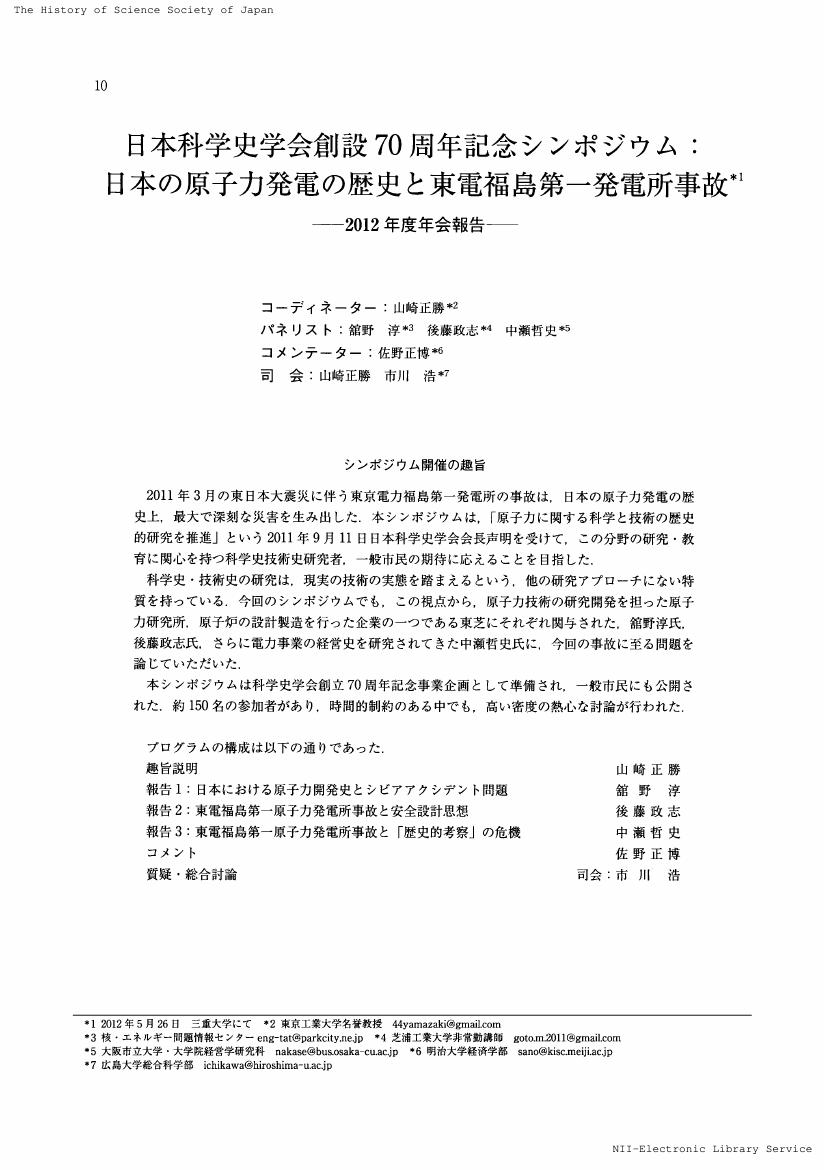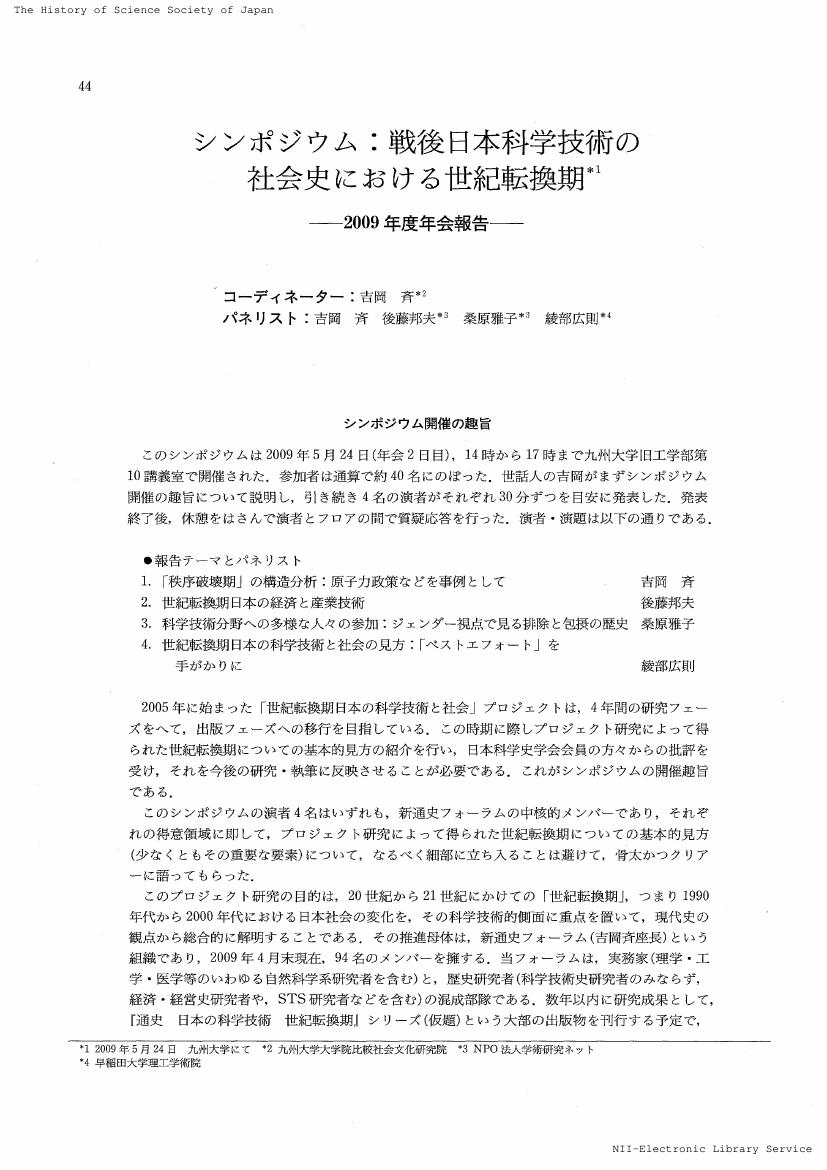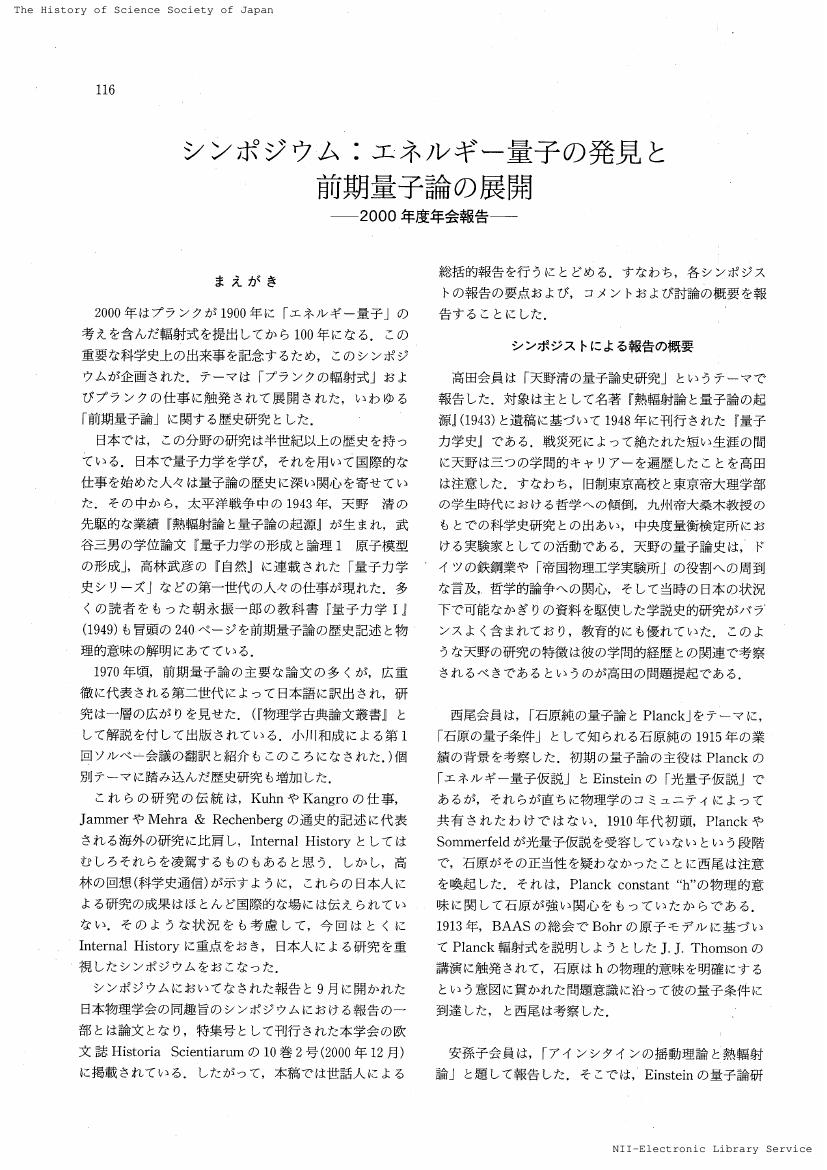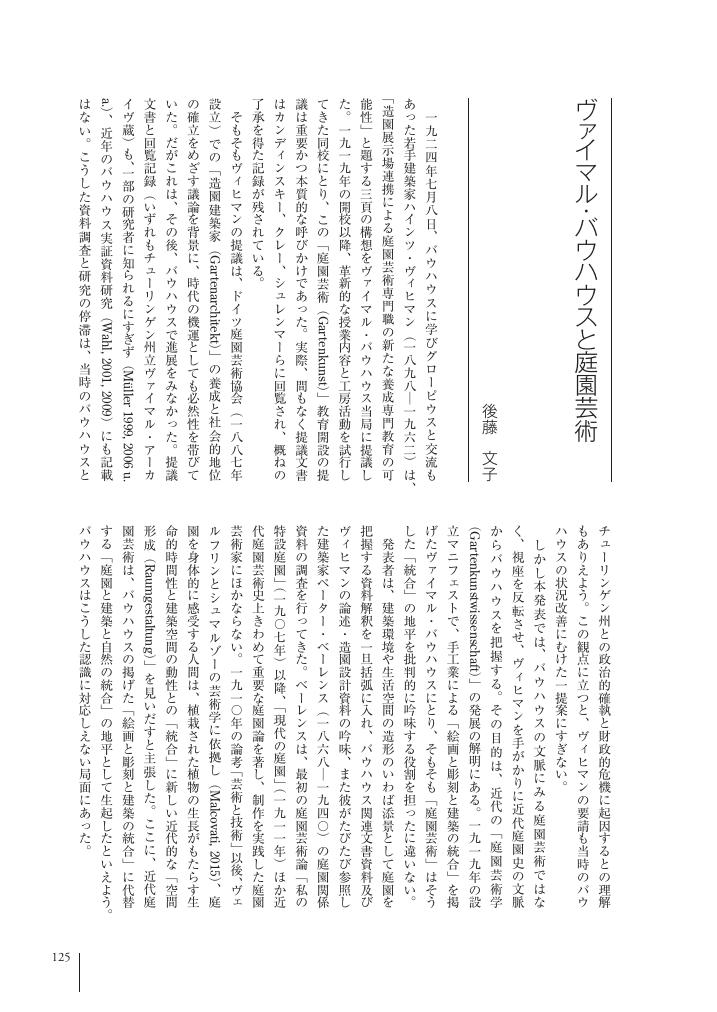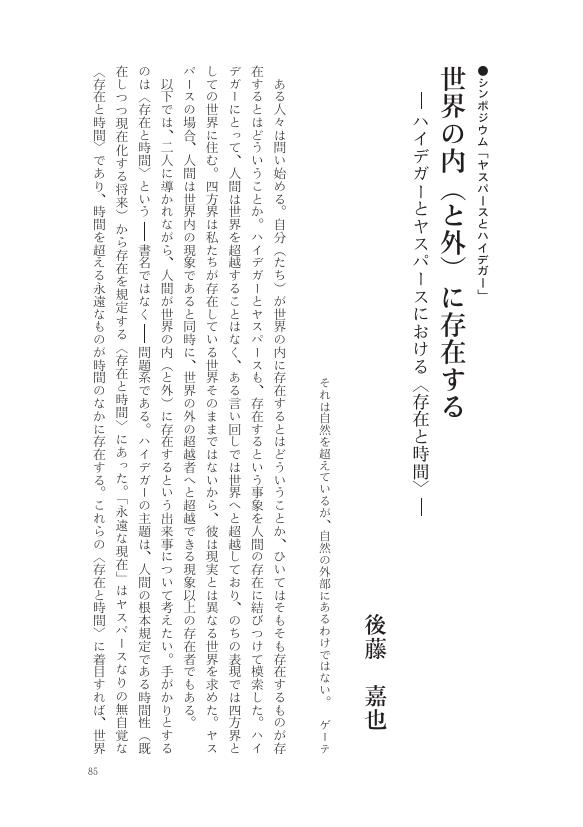- 著者
- 後藤 拓也
- 出版者
- 公益社団法人 日本地理学会
- 雑誌
- 地理学評論 Series A (ISSN:18834388)
- 巻号頁・発行日
- vol.90, no.5, pp.526-528, 2017 (Released:2022-03-02)
1 0 0 0 OA 日本科学史学会創設70周年記念シンポジウム,2012年度年会報告
1 0 0 0 OA シンポジウム:戦後日本科学技術の社会史における世紀転換期,2009年度年会報告
1 0 0 0 OA シンポジウム:日本のコンピュータ史 研究開発における諸機関の連携-2008年度年会報告-
1 0 0 0 OA エネルギー量子の発見と前期量子論の展開 : 2000年度年会報告
- 著者
- 後藤 邦夫
- 出版者
- 日本科学史学会
- 雑誌
- 科学史研究 (ISSN:21887535)
- 巻号頁・発行日
- vol.40, no.218, pp.116-117, 2001 (Released:2021-08-17)
1 0 0 0 OA 20世紀物理学史試論 : 2000年度年会報告
- 著者
- 後藤 邦夫
- 出版者
- 日本科学史学会
- 雑誌
- 科学史研究 (ISSN:21887535)
- 巻号頁・発行日
- vol.40, no.217, pp.41-48, 2001 (Released:2021-08-17)
1 0 0 0 OA R A Millikanによる絶対値qの決定(Ⅱ) -oil-drop法完成への道-
- 著者
- 後藤 美智子
- 出版者
- 日本科学史学会
- 雑誌
- 科学史研究 (ISSN:21887535)
- 巻号頁・発行日
- vol.27, no.167, pp.152-165, 1988 (Released:2021-09-06)
Along with the purpose showed in the preceding paper (Journal of History of Science, Japan, No.165, 9(1988)), in this paper, clarified are the processes of Millikan's determination of the absolute value of e. It is noted that these processes are featured by the relation to Stokes' law. At this point of view, especially noted Millikan's purely empirical attitudes to the criticism and the challenge from PerrinRoux since Solvay Congress (1911). These had led Millikan to resolve the discrepancy between Cunningham's theoretical correction term to Stokes' law and Millikan's empirical results. Millikan's investigation of the slip coefficient and the complete law of fall using the oil-drop method brought about the conclusion for his correctness. These investigations completed the final stage of the oil-drop method and furthermore arose the new problems of the kinetic theory. Controlling his measurable objects at will, selecting the limiting factors exactly, and finally converting particular error sources into the new methods were the elements supporting his active attitude, "independently of theory". Millikan's "empirical" method was not only distinguished from the phenomenology in early 20th century but also a struggle against it. These conclusions are essentially opposed to the interpretations by Holton's "thematic presupposition" and Kargon's "conservative mode".
1 0 0 0 OA R. A. Millikanによる絶対値eの決定(Ⅰ) -oil-drop法完成への道-
- 著者
- 後藤 美智子
- 出版者
- 日本科学史学会
- 雑誌
- 科学史研究 (ISSN:21887535)
- 巻号頁・発行日
- vol.27, no.166, pp.93-103, 1988 (Released:2021-09-06)
- 著者
- 後藤 美智子
- 出版者
- 日本科学史学会
- 雑誌
- 科学史研究 (ISSN:21887535)
- 巻号頁・発行日
- vol.27, no.165, pp.9-23, 1988 (Released:2021-09-21)
In this paper, clarified are the motivation leading the development and the contrivance featuring the processes of Millikan's verification of the elementary electrical charge, with the expectation as a case study for the new implication of the experimental researches in early 20th century physics. The controversy on the atomic theory, occurred in St.Louis Congress (1904), and Millikan's own photo-electric effect research drove him to the momentous question as to the reality of "the electron as the natural unit of electricity". Throughout his observational process ―"seeing the electron―, the confidence in and the limiting factors of his experimental apparatus are particularly noteworthy, as well as the active figures in his experimental methods in this period (1906-1911), especially in the process of converting the capture of ions by water droplets, found in the balanced method, into the core of his next oil-drop method. As to the process under consideration, his essential result was the direct verification of the atomic interpretation of both electricity and matter, confirmed independently of the uncertain theory of Stokes' law of fall of a small spherical body through a gas.
1 0 0 0 OA ヴァイマル・バウハウスと庭園芸術
- 著者
- 後藤 文子
- 出版者
- 美学会
- 雑誌
- 美学 (ISSN:05200962)
- 巻号頁・発行日
- vol.70, no.2, pp.125, 2019 (Released:2021-05-08)
1 0 0 0 OA 世界の内(と外)に存在する ハイデガーとヤスパースにおける〈存在と時間〉
- 著者
- 後藤 嘉也
- 出版者
- 東北哲学会
- 雑誌
- 東北哲学会年報 (ISSN:09139354)
- 巻号頁・発行日
- vol.33, pp.85-106, 2017 (Released:2022-07-30)
1 0 0 0 OA 懐疑主義の源流とその波及 現代哲学の一局面を中心に
- 著者
- 後藤 嘉也
- 出版者
- 東北哲学会
- 雑誌
- 東北哲学会年報 (ISSN:09139354)
- 巻号頁・発行日
- vol.26, pp.45-54, 2010 (Released:2022-07-29)
1 0 0 0 OA 大会報告
1 0 0 0 OA 堀江宗正著『ポップ・スピリチュアリティ――メディア化された宗教性』
- 著者
- 後藤 正英
- 出版者
- 宗教哲学会
- 雑誌
- 宗教哲学研究 (ISSN:02897105)
- 巻号頁・発行日
- vol.38, pp.124-128, 2021-03-31 (Released:2021-11-02)
1 0 0 0 OA (フォーラム)「新しい世界史の運動」と歴史学研究
1 0 0 0 パーキンソン病の非運動症状に対する音楽療法の有効性
アルツハイマー型認知症患者に対しては音楽療法が有効という報告は多くあるが、パーキンソン病(Parkinson disease、以下PD)患者における非運動症状(認知機能低下、抑うつなど)に対して音楽療法が有効であるという報告は少ない。また、現時点ではPD患者の非運動症状に対する根本的治療法はない。本研究では認知機能の低下を伴うPD患者へ音楽療法を行い、その有効性を検証することを目的とする。具体的に、音楽療法士による小グループでの音楽療法を一定期間行い、評価スコアを用いて非運動症状が改善したかを評価する。また、介護者へのインタビューも行い、負担の軽減がみられたかを評価する。
1 0 0 0 小学生の援助要請の特徴
1 0 0 0 OA 生物・心理・社会モデルによるレジリエンスの理解と学校教育への適用
- 著者
- 池田 誠喜 芝山 明義 後藤 正彦 Seiki IKEDA Akiyoshi SHIBAYAMA Masahiko GOTHO
- 出版者
- 鳴門教育大学
- 雑誌
- 鳴門教育大学研究紀要 = Research bulletin of Naruto University of Education (ISSN:18807194)
- 巻号頁・発行日
- vol.34, pp.109-119, 2019-03-11
This paper examines the resilience understanding by biological, psychological and social models and the application to school education. We examined resilience, with particular emphasis on biological models. The interaction between the gene and the environment, the biological response of stress, the relation with specific brain organs, etc. were reported. As a result, we presented a development model of resilience based on biological, psychological and social models.
1 0 0 0 日本語版対人反応性指標の因子構造に関する探索的検討
- 著者
- .*日道 俊之 河村 悠太 後藤 崇志
- 雑誌
- 日本心理学会第86回大会
- 巻号頁・発行日
- 2022-07-29
- 著者
- 宮津 大輔 秋吉 正貴 山下 大貴 立石 裕樹 後藤 貴央 與田 賢作 安倍 ひろみ 田中 博和 平川 雅章 片岡 泰文 首藤 英樹
- 出版者
- 一般社団法人日本医療薬学会
- 雑誌
- 医療薬学 (ISSN:1346342X)
- 巻号頁・発行日
- vol.42, no.4, pp.271-277, 2016-04-10 (Released:2017-04-10)
- 参考文献数
- 17
Fosphenytoin (FOS) is a phosphate ester prodrug developed as an alternative to intravenous phenytoin for acute treatment of seizures. Although both FOS and phenobarbital (PB) are used for status epilepticus as second-line drugs, there is no data on their comparative efficacy and safety. We retrospectively analyzed data from children treated with FOS or PB for convulsive status epilepticus and acute exacerbation of seizures. Our aim was to compare the efficacy and safety of intravenous FOS with those of intravenous PB for convulsive status epilepticus and acute exacerbation of seizures. Seventy-seven children were included in the study: 54 received FOS, and 23 received PB. The primary end point was recurrence of seizures and drug-related adverse events. The response rate, defined as no recurrence of seizures within 24 hours after termination of seizure, was 92% (50/54) and 95% (22/23) in FOS group and in PB group, respectively. Adverse events occurred in 27% (15/54) of patients in FOS group and in 95% (22/23) of patients in PB group (P < 0.01). Although no serious adverse events occurred in patients in both FOS group and PB group, the incidence of both sedation and disturbance of consciousness were significantly higher in PB group than FOS group. From these results, FOS is recommended as second-line drugs for status epilepticus and acute exacerbation of seizures. However, the optimal serum concentration achievement rate was significantly lower in FOS group than PB group. To maintain optimal serum phenytoin levels (10 - 20 µg/mL), higher doses of FOS might be required.

